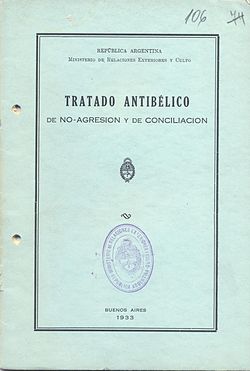
The Anti-war Treaty of Non-aggression and Conciliation (also known as Saavedra Lamas Treaty) was an inter-American treaty signed in Rio de Janeiro on October 10, 1933.[1][2] It was the brain-child of Carlos Saavedra Lamas, who was the Argentine Minister of Foreign Affairs at the time the treaty was concluded. It was signed by representatives of Argentina, Brazil, Chile, Mexico, Paraguay and Uruguay. The US government acceded to the treaty on August 10, 1934. The treaty went into effect on November 13, 1935. It was registered in League of Nations Treaty Series on November 28, 1935.[3]
The treaty was terminated with the entry into effect of the Pact of Bogotá, concluded on April 30, 1948 (article 58).[4]
The treaty had a persistent impact on norms related to peace and conflict in the Western hemisphere.[5]
- ^ Jessup, Philip C. (1933). "The Saavedra Lamas Anti-War Draft Treaty". American Journal of International Law. 27 (1): 109–114. doi:10.2307/2189791. ISSN 0002-9300.
- ^ Jessup, Philip C. (1934). "The Argentine Anti-War Pact". American Journal of International Law. 28 (3): 538–541. doi:10.2307/2190381. ISSN 0002-9300.
- ^ League of Nations Treaty Series, vol. 163, pp. 394-413.
- ^ American Treaty on Pacific Settlement, Signed at Bogotá, April 30, 1948
- ^ Schenoni, Luis L; Goertz, Gary; Owsiak, Andrew P; Diehl, Paul F (2024). "The Saavedra Lamas Peace: How a Norm Complex Evolved and Crystallized to Eliminate War in the Americas". International Studies Quarterly. 68 (2). doi:10.1093/isq/sqae047. ISSN 0020-8833.